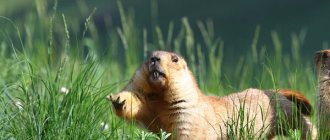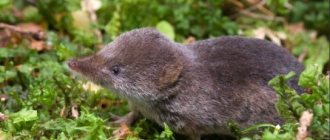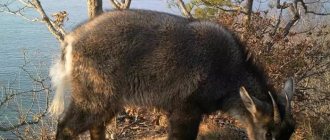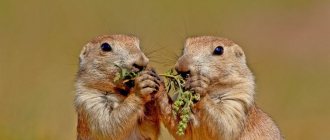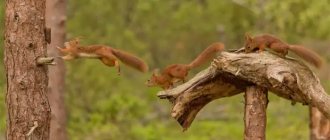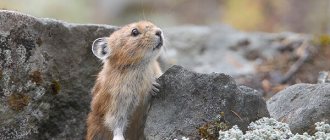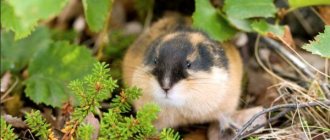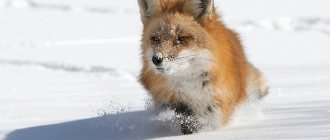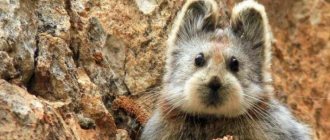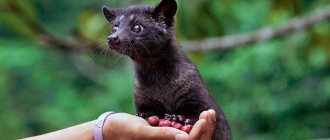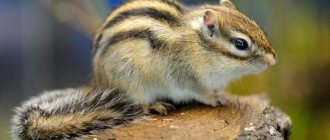The gray marmot is a mammal from the order of rodents and belongs to the squirrel family. It is also commonly called the Altai marmot.
Its main habitat is the Tien Shan and Altai mountains. In the northwest it can be found in the Kemerovo, Tomsk and Novosibirsk regions. In 1934, it was brought to Dagestan, but local residents almost immediately destroyed the entire population.
The gray marmot has a powerful, muscular body, up to 70 cm in length, and a small tail of 12 cm. The head is massive, slightly elongated, the eyes are medium-sized, and the ears are not large. The paws are powerful with large and sharp claws. The foot is wide. The marmot's hair coat is sandy-yellow in tone, and its belly and head cap are dark brown. The coat is medium length, very soft, with good undercoat.
The main activity of the gray marmot is distributed over the morning and evening hours, and only in areas of active fishing does it switch to a nocturnal lifestyle. The gray marmot is largely considered a mountain dweller. She always creates shelters herself, digging holes, with a complex system of channels, with an abundance of chambers, both food and sleeping, and a large number of additional exits. Animals of this species usually live in one place all their lives and only in exceptional cases do they leave their permanent habitat. The main factor that influences its activity is the weather. Surkip animals that create colonies and many families live in one hole. This species, like all of the severe order, hibernates and, closer to autumn, begins to actively feed, stocking up on fat deposits for the winter.
Appearance
The gray, or Altai, or Mountain Asian marmot is a large, stocky, massively built rodent with short ears and paws. Outwardly, it is very similar to the boibak and tarbagan, but the wool is longer and softer. The marmot's head is slightly flattened, its neck is short, and its eyes are large. The body length is up to 65 cm, the tail length is up to 13 cm. The zygomatic arches are widely spaced and diverge back only slightly weaker than those of the bobak. In the spring, after hibernation, marmots weigh 2.4–4.5 kg, and in the fall, before burrowing, up to 8 kg. The fur of the animals is thick and soft.
The color of the top is sandy yellow. There are black or black-brown ripples on the back. The belly is darker and redder than the sides. The head, neck and front of the back are darker in color. In this case, the dark coloration of the top of the head is well developed, but is usually not separated from the coloration of the upper surface of the neck and the front of the back; the exception is some individuals in faded early spring fur. There are white spots around the lips and on the chin. The tail is without black at the end, the top is the same color as the back, and the bottom is dark.
Lifespan
In natural conditions, marmots live quite a long time, from 16 to 25 years, but when kept in captivity, this value drops sharply and ranges from 5 to 7.
The marmot is a valuable animal and is hunted on the territory of the Russian Federation under special protection, since most of its population has been exterminated. They exterminated it in pursuit of its fat, which has some kind of unique medicinal qualities. In the mountainous regions of Central Asia, hunting for it continues to this day, using both meat and fat.
Spreading
Habitats range from dry slopes of logs and river valleys of the West Siberian forest-steppe and low steppe uplands of the Kazakh Highlands to the highlands inclusive: the alpine belt and cold desert of the central Tien Shan and the alpine xerophytic tundra of Altai. The highest population density of marmots currently occurs (obviously, not without human influence) in alpine meadows, and the lowest in the desert highlands. Apparently, the conditions of the mountain steppe should be considered optimal; in those places where the colonies are difficult for humans to reach, even now the Altai marmot reaches significant numbers (central Tien Shan).
In mountains with a developed forest belt, it settles in clearings, at its upper border and among the alpine bushes bordering it. To the east and south of Tomsk it lives along the forest-steppe slopes of ravines and river valleys with sparse tree vegetation, avoiding meadow areas.
Northern populations living in the south of the Novosibirsk, Kemerovo and Tomsk regions were identified in the early 2000s as a separate species - the forest-steppe marmot . In 1934, it was brought to the Gunib plateau in Dagestan, but was practically exterminated there by the local population; in recent years, there has been no information about surviving animals.
Taxonomy
The gray marmot is a Palearctic species in the subgenus Marmota
.
It is most associated with the forest-steppe marmot ( Marmota kashchenko
), which was considered a subspecies of the gray marmot, until recently considered a separate species.[4][5][9]
The bobak marmot ( Marmota bobak
) is the sister group to these species, and the gray marmot is thought to have descended from this lineage.[5]
The gray marmot has two recognized subspecies. Marmota baibacina baibacina
and
Marmota baibacina centralis
.[4]
Lifestyle
Marmots are quite active animals: on flat areas they can run at speeds of up to 15 km per hour, and jump up rocks to a height of half a meter. Due to the special structure of the spine and skull, marmots are able to squeeze into very narrow crevices among stones.
Marmots lead a family lifestyle. In some cases, families grow to 15–20 animals. From time to time, young marmots from other families are accepted into the family. The elders in the family dominate the younger ones, the males dominate the females.
- Jungle animals
- Saber-toothed tiger
- 50 facts about kangaroos
- long eared hedgehog
- Cross spider
- Reptiles
As soon as one of the animals becomes alarmed (for example, when a wolf, dog or person approaches the colony), a cry is heard - the first signal of an approaching threat; in adults, a slightly hoarse “kwikvik”, in young ones “fit-filt”. But this is only the first signal; as soon as the groundhog sees real danger, he immediately hurries to the hole. The sight of a fellow marmot running towards shelter causes an immediate reaction from all the marmots in the neighborhood, and they also hide in holes.
Marmots have different types of burrows. Summer burrows are the most complex: there are many passages, there is a nesting chamber and special holes; this entire system is connected to the surface by several (up to 15) outputs. The total length of one burrow can reach 70 m. Winter burrows are simpler; in them, the nesting chamber is located in soil impermeable to water. Protective burrows are small, short, with one entrance, without a nesting chamber.
At the entrance to the hole there is always a well-sunk area where the owners of the hole like to relax.
They say about a lazy person: “Sleeps like a groundhog.” And this is no coincidence - after all, these animals spend 7-8 months in hibernation.
Marmots prepare for hibernation very thoroughly: by feeding heavily, they accumulate subcutaneous fat. Before going into hibernation, they do not eat anything for a while in order to fall asleep on an empty stomach.
At the end of August - September, marmots in families or groups (from 2-5 to 20-24 individuals in one hole) move to wintering holes. The animals close the entrances with plugs made of a mixture of earth and stones. All winter underground they do not feed, hardly move and sleep peacefully.
Seasonal and daily activity, like that of other mountain species, significantly depends on the altitude of the area above sea level, slope exposure and weather conditions. The periods of hibernation and awakening can vary greatly (by 20 or more days) depending on the slope exposure, even in the same gorge. In places where marmots are pursued or disturbed by humans, their usual two-phase (morning and evening) activity is sharply disrupted, to the point of adapting to feeding at night.
Nutrition
The gray marmot, apparently, has a more pronounced need for feeding on succulent plant foods than the lowland species: they eat mainly leaves, flowers and young shoots. In early spring, marmots eat last year's plant debris and use up the remaining fat accumulated since the fall. Although the gray marmot feeds mainly on plant foods, it also very often eats invertebrate animals. Among invertebrates, it eats locusts, mollusks, butterfly caterpillars and other insects.
Groundhog food
The main diet of marmots is plant foods (roots, plants, flowers, seeds, berries, etc.). Some species, such as the yellow-bellied marmot, eat insects such as locusts, caterpillars and even bird eggs. An adult marmot consumes about one kilogram of food per day.
During the season from spring to autumn, the groundhog needs to eat enough food to gain fat, which will support his body during the entire winter hibernation.
Some species, for example, the Olympic marmot, gain fat for hibernation more than half of their total body weight, approximately 52-53%, which is 3.2-3.5 kilograms.
You can see photos of marmot animals with fat gained for winter; this rodent in the fall has the appearance of a fat Shar Pei dog.
Reproduction
The gray marmot, like other species of this genus, has only one litter per year. The mating season begins in the spring (April - May) after awakening, sometimes, apparently, even before leaving the burrows. The female brings from 2 to 6 cubs. Marmots are born naked and blind. At first they feed only on their mother's milk, and at the age of 40 days they begin to come to the surface and eat grass. The babies are very active, they constantly play with each other and with their mother.
Gray marmot - marmota baibacina kastsch. Changes in numbers
Severe spring-summer droughts are common in boibak habitats. Significant burning of vegetation leads to a decrease in their numbers, which was noted by A. A. Silantyev (1894). According to his information, in the Saratov region, due to lack of food, due to drought in 1891, these animals went into hibernation poorly nourished. In the spring of 1892, they emerged from their holes very exhausted. That spring, the exhausted boibaks, even in danger, could not reach the hole, but lay down exhausted on the way to it. Many of them died from predators, and some probably died from exhaustion before leaving their burrows. Severe droughts apparently lead to a large decrease in marmot population density in Kazakhstan, since in the spring of 1958 we found weakened marmots pecked by birds, even after a slight burning of the vegetation in mid-summer 1957.
True, severe droughts are observed relatively rarely. In addition, bobbacks in Kazakhstan are relatively adapted to them. During the years of spring abundance of food, they become fat very quickly and can lie down as early as July (Shubin, 1963), avoiding drought, which often occurs at the end of summer. In years of early drought, they occur later, after the secondary vegetation of plants. In Kazakhstan, boibak
gives birth to cubs much earlier than in the European part of the USSR. They emerge from their burrows when food is abundant, accumulate fat faster, and survive minor droughts relatively well. However, in the early stages of reproduction, the cubs often die during lactation, since in some years the females are very exhausted due to the late development of plants. For example, in 1958 the snow began to melt late. Large thawed patches appeared only 10 days (April 15-16) after the bobaks came out. A long cold spell in the second half of April and the first ten days of May greatly delayed the growing season of plants. It rained and snowed often. Lack of food and cold, damp weather led to greater depletion of the animals (including lactating females); the number of marmot chicks in families was half that in the favorable year of 1957 (Tables 49, 50), although the intensity of reproduction in these years was almost the same. Even fewer marmots were observed in 1959, and not only in the south of the Tselinograd region, but also in the Ruzaevsky district of the Kokchetav region. If in 1957 in June and later they made up over 70% of all marmots, then in 1959 - only 21-24%. The average number of income earners in families changed accordingly. According to M.I. Ismagilov (oral communication), in the spring of 1959 the feeding conditions for bobak were poor.
Especially many marmots died in 1956 in the Ruzaevsky district of the Kokchetav region in July and August. That year, according to hunter I.D. Martin (oral communication), bobcats were not encountered at all. Judging by the age composition of the population, there were very few of them further south. Comparing the weight of marmots caught in April (Fig. 68), we see that in 1957 there were almost no one-year-old animals, and in 1958 there were almost 50%. This is also indicated by the age composition of the population. In 1957 in the Tselinograd region near the village. Ladyzhenka yearlings produced only 0.8%, and in 1958, south of the lake. Shoindykul two-year-olds caught 4.5%. In 1957, there were 27.17% of two-year-olds; therefore, in 1955 there were almost 6 times more income-bearing children than in 1956.
In 1956, spring in Northern Kazakhstan turned out to be very long and cold. In the North Kazakhstan region, snow fell even in early May. Bad weather conditions probably caused high mortality among boibak cubs.
The drought of the previous year apparently has a lesser effect on the death of young animals. Thus, in 1958 there were quite a lot of arrived individuals, as already mentioned above, despite the relatively dry previous year of 1957.
Thus, climatic conditions greatly influence the number of bobak, but most of all it is reduced by human activity. The range of the steppe marmot in Europe in the 18th–19th centuries. was significantly reduced as a result of the plowing of the steppes and persecution by man. Due to the excessive fishing of bobak at the end of the last - beginning of the current century, its reserves were severely undermined in Kazakhstan. According to Ya. Ya. Polferov (1896), in the 19th century. this
the beast was very numerous. According to I.V. Turkin and K.A. Satunin (1900), only at the Irbit and Nizhny Novgorod fairs from 1880 to 1895 annually
M. baibacina baibacina lives on mountain groups (Ulken-Burkitty and Vakhty, and possibly on a number of others), which are almost not isolated from the main part of the gray marmot’s range, but are located only on its outskirts
with some signs of the boibak (relatively more massive skull, less long hair, weaker development of the dark ends of the guard hairs), but they quickly disappear as they move away from the border of the range to the south - into its depths.
All this is the presence of boibaks in the mountains of the Kazakh Highlands (Ermentau, Zheltau, Kuu, etc.), the presence of some features of the gray marmot in them, the presence of small isolated populations of “hybrid” marmots in the territory between the ranges of the boibak and the gray marmot, as well as the manifestation of some The signs of boibak in the gray marmot at the northern border of its range are the result of a single process. It consists in the fact that with the pulsation of the boundaries of the ranges of marmots of these two species, there was a relatively long and, probably, repeated contact between them, accompanied by one or another (different in different places) degree of hybridization with a general tendency of reduction of the range of the gray marmot, fragmentation and retreat to southeast, the settlement of boibak in the same direction, and the absorption of small isolated residual populations of the gray marmot by it (Kapitonov, 1966a).
What specific characteristics differ between the bobak and the gray marmot from the Kazakh Highlands? In the literature this
the issue is not sufficiently covered, since all the authors took the gray marmot as a whole and therefore some of the characteristics characteristic of this animal in the Tien Shan and Altai are weakly expressed or absent in the Kazakh Highlands.
Therefore, we compare the lowland bobac (M. bobac schaganensis)
from Central Kazakhstan and the gray marmot
(M. baibacina baibacina)
from the Kazakh Highlands.
The gray marmot has a more elongated, less massive muzzle, and the upper line of the head in profile is noticeably flattened, on average larger and rounder auricles, less overgrown with hair, longer (as a percentage of the body length) vibrissae, a less developed connective tissue layer of skin on the distal parts of the nose, the eyes are larger, on average, relative to the body length, a longer tail (25.5 in males and 24.5% in
females of the gray marmot and, respectively, 21.3 and 18.3% for the bobak).
The hair of the gray marmot is more luxuriant and higher than that of the bobak. So, in 10 copies. baybakov from the river basin Tersakkan and 10 copies. of the gray marmot from the Temirshi, Koshubai and Chingiztau mountains, the average height of fur (in mm)
on the side of the middle part of the body was: the highest height of guard hairs was 31.6 in boibak and 42.0 in gray, the average height of guard hairs was 24.2 and 34.8, respectively , the average fluff height is 16.4 and 22.9. Moreover, the extreme values of these indicators did not transgress.
Quite clear differences are also noted in the color of molted animals, while the old (spring-summer) hair coat is much less distinguishable. This is caused not only by the fading and breaking off of the ends of the guard hairs, but also by the fact that during the rutting period in the spring, boibak males, according to our observations, often pour urine on their belly, chest, throat and muzzle, which is why these parts of the body acquire a dark buffy color (especially the sides of the muzzle). -brown color, characteristic of the gray marmot at this time of year. After molting it disappears. Under the influence of urine, the fur also darkens in the genital area (including in females), which is also observed in other species of marmots, sometimes even in marmots. The differences in the color of the gray marmot and the bobak at the end of the molt are mainly in the more buffy-reddish (sometimes buffy-blackish) coloring of the lower surface of the body in the first and in the greater darkening of its head, back and sides. The latter is due to the greater height of the dark (main and distal) fur zones of the gray marmot. mm, respectively
The extreme values of these indicators did not transgress.
The skull of the gray marmot (Fig. 71) differs from that of the boibach (Fig. 60) by open eye-orbital notches (in boibaks, including mountain ones, they are semi-closed), a slightly concave frontal platform (this is also typical of some mountain boibaks), slightly curved downwards supraorbital processes thin at the base and slightly running towards the end. The nasal bones of the gray marmot are relatively wider in front, tapering evenly by 4-8 mm
protrude beyond the nasal processes of the premaxillary bones. In the boibak, the outer lines of the nasal bones in the posterior half are almost parallel to each other and barely protrude beyond the nasal processes of the premaxillary bones.
The gray marmot is also distinguished by a large, usually elongated, pre-wing opening and a 1.5-2 times smaller lacrimal opening (in boibak, on the contrary), a rounded ventral edge of the lower jaw in a section along a perpendicular, restored to its inner upper edge opposite the fourth molar ( in the boibak the edge is sharp), a more developed anterior upper tubercle (in comparison with the lower one) on the masseteric area of the lower jaw (in the boibak, on the contrary) and its articular process more bent inwards. In addition, the gray marmot differs from the bobak in the poorly developed superior-posterior processes of the pterygoid processes, which almost never close with the anterior-internal processes of the auditory drums. And in a bobak they, as a rule, close together (if not broken off).
The gray marmot also differs from the bobak in the structure of the auditory ossicles (Ognev, 1947) and baculum (Kapitonov, 1966a), an elongated scapula and its more (absolutely and relatively) long caracoid process. Thus, the ratio of its length to the largest lateral diameter of the articular surface of the scapula in the plain boibak is 0.84-1.08, on average 1.00, in the mountain bobak - 0.80-1.06, on average 0.90, and in the gray marmot - 1.08-1.31, average 1.24. The extreme upper point of the gray marmot's thigh is formed by the surface of its head, and in the bobak - the dorsal edge of the large swivel.
The tibia of the gray marmot of the Kazakh Highlands is characterized by the absence or weak development of a notch on the articular surface of the distal epiphysis, which is well developed in the boibak (Kapitonov, 1966a).
The caudal spine of the gray marmot has 21-23 vertebrae, while the bobak has 19-20. Thus, the gray marmot from the Kazakh Highlands (M. b. baibacina)
well and in many ways different from boibak
(M. b. schaganensis).
Therefore, despite the presence of transitional forms between them, the bobak and gray marmot should be considered independent species.
Subspecies differentiation of the gray marmot has not been sufficiently studied. Of the four described subspecies: Altai (M. b. baibacina
Kastsch.) (Kashchenko, 1899), Tien Shan
(M. b. centralis
Thomas) (Thomas, 1909), Ognev
(M. b. ognevi
Scalon) (Skaloy, 1950) and Kashchenko (M.
b. kastschenkoi
Stroganov et Judin) (Stroganov and Yudin, 1956) only the first two are common in Kazakhstan.
Altai gray marmot
—
M. b.
baibacina (Fig. 69, 70) is characterized by a very dark coloration of the upper body, the head being darker than the back, and the transition between them is gradual. The dark brown coloration of the cheeks usually also affects the vibrissae area. The belly is not bright, but yellowish-rusty with an admixture of brown tones. Distribution: Altai, Saur, Tarbagatai, Kazakh Highlands, Chingiztau.
Most authors (Ognev, 1947; Gromov, 1952, 1963, 1965; Galkina, 1962) quite rightly classify the gray marmot from the Kazakh Highlands as a subspecies M. b. baibacina.
However, there are some differences between the animals of the Kazakh Highlands (mountains Temirshi, Koshubai, Kent, Chingiztau - 58 specimens) from the “Altai” (Tarbagatai, Saur and Altai - 67 specimens). They are as follows:
1) In marmots from the Kazakh highlands, the chest and belly are duller, the red color in many individuals is largely replaced by yellow-ocher, often with a blackish tint; The spines of the back are darker;
2) in “Altai” marmots, the abdominal rusty-ocher stripe is narrower, it is more clearly and sharply separated from the usually lighter (especially in the anterior half of the body) sides. In individuals from the Kazakh Highlands, this stripe is wider, more blurred and less clearly demarcated from the darker sides than in the “Altai” individuals. Moreover, the brown or almost black mottled sides of specimens from the highlands descend lower and sometimes merge with the ocher belly;
3) the white spot on the lower lip of the “Altai” marmots is lighter and closer to pure white than in specimens from the highlands. The whitish border of the nasal planum in the former is lighter and more distinct than in the latter;
4) in the “Altai” marmot the difference between the head and back, which is dark on top, is greater (the head is darker) than in individuals from the highlands, although the transition in both is gradual;
5) in “Altai” animals, the upper dark zone of fur on the center of the back is on average lower (11 mm),
than in individuals from the highlands (13
mm),
and the lower one is dark on the contrary (12.6 - in Altai and 10.7
mm
- in the highlands).
The overall height of the hairline (middle of the back) in individuals from Altai is noticeably somewhat lower than in the highlands
, as noted by N. Berger (1936).
He also points to a lower density of hair (1944 hairs per 1 cm2)
and shorter downy hair in the marmot from the Kazakh Highlands (Semipalatinsk region) compared to those of animals from Altai (2056 hairs per 1
cm2),
but these data are about the density of the fur in both cases are somewhat underestimated. No significant differences were found in the structure of the skull, auditory ossicles and baculum (10 specimens from the Kazakh Highlands, 10 from Tarbagatai, 20 from the Ukok Plateau in Altai and three from Saura were examined).
What do steppe marmots eat?
The steppe marmot feeds on succulent and soft plant food, and its favorite plants are wild oats, wheatgrass, chicory, clover and field bindweed. In different seasons of the year they prefer different parts of the plant. Thus, in early spring, marmots eat mainly overwintered rhizomes and bulbs; in summer - young sprouts of cereals and herbs, as well as flowers. In the second half of summer, when the steppe vegetation burns out, boibaks move further and further from their burrows in search of wet areas with lush grass. Ripe fruits and seeds in their stomachs are not digested, scattering along with the droppings. During the day of fattening, the bobak eats up to 1-1.5 kg of plant mass. The steppe marmot also consumes animal food - locusts, mollusks, caterpillars, ant pupae, usually eating them along with grass. The bobak does not make any reserves for the winter. He usually does not drink water, content with the moisture contained in plants or morning dew.
Behavior of steppe marmots when in danger
Marmots emerge from hibernation at the end of February - beginning of March. Having fattened up a little, they begin to repair or dig new protective holes; later - to correct and expand residential holes. Their activity begins at sunrise, when the animals wake up and go to feed. On the surface, marmots maintain visual (postures in a column) and sound (roll call, danger signal) communication. Usually two marmots in a colony act as sentinels while the others feed. The marmot's hearing is less developed than its vision, so the main signal of danger is not so much a whistle as the sight of a relative running towards the hole. Seeing this, other marmots also rush to the holes, even if there was no scream. At noon, bobbacks usually rest in their burrows, and in the evening they go out to feed again. They spend 12-16 hours on the surface of the earth. The marmot moves in fits and starts, sometimes stopping and freezing in place. Fleeing from pursuit, it runs quite quickly, reaching a speed of 12-15 km/h on flat areas, and tries to hide in the nearest hole.
